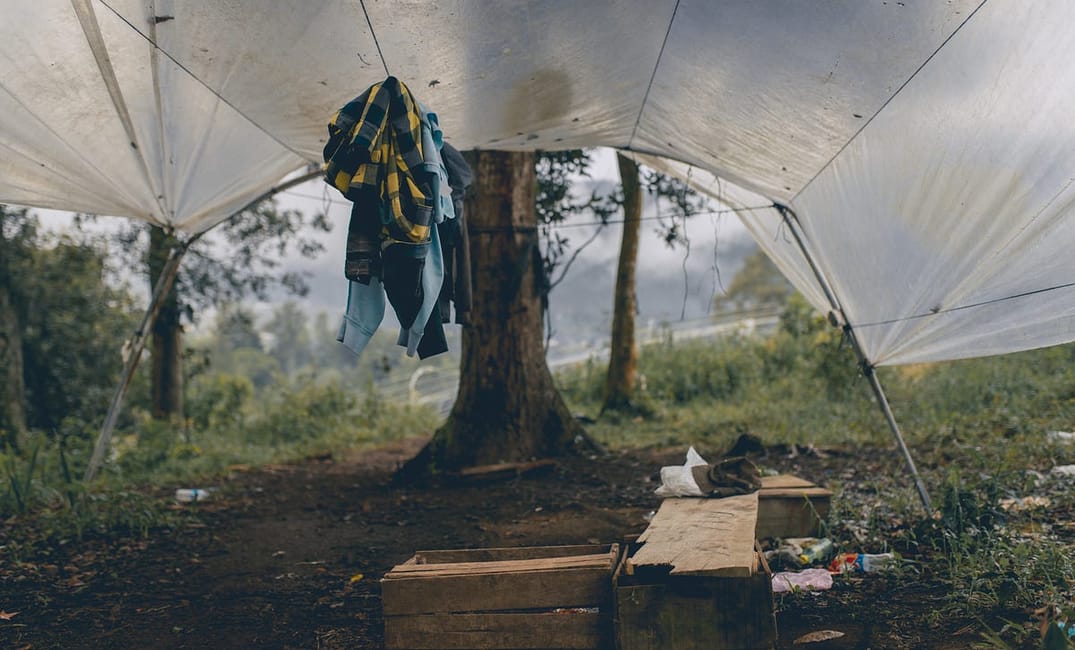
Two weeks before Thanksgiving, I noticed a new sign sponsored by the City of San Jose in my neighborhood park. “Welcome to Saint James Park,” it reads. “Thank you for helping those in need.” It lists several bullet point suggestions — names of nearby churches and small food banks that offer weekly hot meals and toiletries to the homeless living in the park, and ways members of the community can lend their support.
Last April, my husband and I moved from Austin to San Jose. We moved for the same reason many others have in the past — a better job opportunity. We live in a small, gray bungalow built in the 1940s in an area near downtown where stately Victorian mansions stand in varying states of disrepair. Most of the neighboring houses have been chopped up and remodeled into living spaces for multiple families and short-term renters. Look through the windows and you’ll spot the original crown molding, stained glass windows and crystal chandeliers. You will also see dirty sheets covering entry ways and stacks of garbage supporting walls in desperate need of a fresh coat of paint. Outside, the sidewalks are covered in blossoms of dried vomit, rotten fruit and garbage. The homeless pick through trash cans looking for items to sell, recycle, or eat.
Reams of brown paper cover storefront windows with handwritten “For Lease” signs. It’s not unusual for a business to appear one day only to close a few weeks later. Empty nail salons, abandoned taquerias, and shuttered neighborhood dive bars serve as squats for the neighborhood homeless.
The situation becomes more depressing the closer you get to downtown.
Men and women of all ages huddle in the doorways of empty storefronts. Some live in shelters made of soiled cardboard boxes and dirty blue plastic tarps. Stolen shopping carts are tied together with twine. Some of the more fortunate live inside their cars and vans, parking them outside grocery stores until a concerned neighbor calls the police. The van doors are propped open slightly to let in air. Plastic bread bags, fast food wrappers, and empty plastic soda bottles accumulate outside the door. The vehicle disappears for a week or two, and then returns. The cycle continues.
The situation becomes more depressing the closer you get to downtown.
Just a street over from the city’s center is St. James Park. A woman who’s been pulling out her hair piece-by-piece beats her chest, swings her hips and howls on the sidewalk. A man sleeps on his back, completely naked, his arms and legs spread out over the grass like a starfish, his entire body on display. Another man openly urinates in a garbage can. A woman lies on her back with her legs spread out, her feet in the air, and her skirt raised above her waist. She scrubs herself with a fresh bar of soap given to her by a Vietnamese volunteer. Various dogs on makeshift leashes obediently sit and stay guarding their owners’ shopping carts.
The homeless people resort to bathing themselves in the green and gold public toilets that can be found on street corners downtown. The doors are propped open allowing passers-by a view of the insides, which are usually covered in feces and garbage. Once a week, city sanitation workers dressed in head-to-toe plastic garments use high-powered hoses to wash away the previous week’s use directly onto the street.
Men and women lie on the ground outside office buildings on West Santa Clara Street. Other men and women in athleisure wear, suits or business casual attire calmly walk around or walk over them, busying their attention with an iPhone and earbuds on their way to work or heading over to Starbucks.
Men and women lie on the ground outside office buildings on West Santa Clara Street. Other men and women in athleisure wear, suits or business casual attire calmly walk around or over them, busying their attention with an iPhone and earbuds on their way to work or heading over to Starbucks.
When I bring these kinds of things up at work, I am looked at as if I am speaking another language, and in a way, I am.
Inside the buildings on West Santa Clara Street, in the heart of one of the wealthiest areas of the United States, some of the most creative minds in the world flock for a chance to work on “noble, world-changing pursuits “— things like building apps mostly used by white males ages 22 to 29 or corporate software that promises to help employees “work smarter, not harder.”
Some of the executives that run these companies are excited about ideas like automation for “operations and process.” One seldom hears them use the words person, people, human, man or woman. The words child or children are used to reference the lack of time being spent with them.
They call the people they hire to execute their plans “headcounts” or “backfill.”It’s easier to fire a low-performing headcount on a Friday afternoon before Thanksgiving than it is to nurture a person who might be having difficulty finding their place in an environment that measures success solely by metrics.
It’s easier to fire a low-performing headcount on a Friday afternoon before Thanksgiving than it is to nurture a person who might be having difficulty finding their place in an environment that measures success solely by metrics.
When hiring new recruits, these companies are no longer looking for culture fits, they’re looking for culture adds. A good culture add is a fresh headcount who won’t mind falling into lockstep with the latest agenda from a new executive.
A good culture add will not bat at an eye when they hear their new coworker repeatedly use disparaging words like “cunt,” if only in jest. They’ll understand that if they’re offended, they should keep it to themselves. They’ll practice the same patience when a male executive declares a meeting over by stating he’s “shot his wad.”
Inside some of these companies, long-term employees loyal to the original mission search for new opportunities, a renewed hope. When they find them, executives offer footnotes in their weekly reports. “We’re hard at work searching for a new backfill to replace ________. Thank you for your service.”
No one wants to challenge these executives for fear of falling out of favor with men nearing fifty wearing hoodies. Those who do are humiliated in front of their teams, their work devalued, their accomplishments unrecognized, their spirits diminished.
No one wants to challenge these executives for fear of falling out of favor with men nearing fifty wearing hoodies. Those who do are humiliated in front of their teams, their work devalued, their accomplishments unrecognized, their spirits diminished.
Headcounts watch each other as they get passed over for raises and title bumps without explanation. They whisper words of encouragement to each other in stolen moments in the corners of their companies’ fully-stocked kitchens or send private Slack messages to each other across open seating that is supposed to foster collaboration and encourage transparency.
They try to shake off another day’s unrealistic expectations before logging off to pick up their kids from school. The next morning, they return to their desks to answer emails and texts from C-Suite executives who despite having children themselves somehow have the time to work through the night and expect everyone else to give up on what matters most, too.
I pass the signs in Saint James Park every day on my way to work. It reminds me: the way business is run in Silicon Valley has a direct effect on the attitudes and behaviors of the people who live and work here. When we neglect to view our peers and colleagues as people, we diminish their value. From there, it’s a short step to denying one’s intrinsic human dignity.
It feels naïve quoting Gandhi, but these words ring true, “The true measure of any society can be found in how it treats its most vulnerable members.”
For a community that self applies the word guru, that dares to use the word “noble” when describing their pursuits, that has the gall to call their work world-changing, I have a hard time subscribing to Silicon Valley’s perverse idea of “purpose.” I’m finding it more difficult to keep my mouth shut and fall in step.
In a culture that champions work above all else, I’m having trouble denying my humanity for the sake of technology.
I came to San Jose because I believed it would be good for my career, and while it would be easy for me to dismiss my experience (I am often tempted to write this year off as a loss), it has challenged me to think more about the value of what I am doing and who I am doing it with. In a culture that champions work above all else, I’m having trouble denying my humanity for the sake of technology.
The bullet point on the signs in Saint James Park that resonates the most with me reads, “Become informed of city resources and help spread awareness.” I’ve tried to discuss the homeless epidemic with almost everyone I’ve met during my eight months here to no avail, met most often with the response, “But what can be done?”
But what can be done? It’s obviously not enough to be made aware of the situation. The homeless epidemic is a scourge many residents have decided to accept as the status quo. Employees of the most successful tech companies preach the value of ignoring our most human qualities — things like respect and value, things like spending quality time with our families without the fear of losing our jobs. The corporate culture of Silicon Valley has created a class of people who are willing to treat others poorly.
The corporate culture of Silicon Valley has created a class of people who are willing to treat others poorly.
With the best and brightest minds and all the money in the world, you’d think someone would’ve thought of something by now. But how does one commodify care? What’s lucrative about convincing people to treat others with respect and dignity? How do you compel someone to invest in a long-term solution that will improve a community’s well-being, but may never turn a profit?
The longer I stay here, the more I’m beginning to think that maybe there just isn’t any ROI in doing the right thing.
And perhaps that’s what I fear most: that we’ve reached the tipping point where it proves too costly to care about each other at all.







